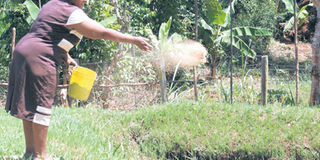I fish Sh45,000 from my pond every three weeks

Margaret Kinyua in her farm in Meru. CHARLES WANYORO | NATION
What you need to know:
- As in other farming ventures, you can only succeed in fish farming if you work with experts.
- I learnt all this information at the Sagana Aquaculture Research Station in Kirinyaga County. I usually attend field workshops there and get professional information regarding fish.
Meru is known for miraa more than anything else, but there are many farming activities taking place here.
The newest one is fish and I am happy to be among those spearheading fish farming in the region, particularly in Meru South sub-county.
My business entails keeping fish and hatching fingerlings. Thereafter, I sell them to residents for meat and farmers, who are growing in numbers.
I started the business four years ago. Two things made me go into fish farming. One, the government was promoting fish farming, mainly keeping Tilapia, and two, there is a stream that passes through my farm in Kibumbu village, where I get water.
When I first heard about fish farming, I was hesitant to engage in it because I didn’t know if I will find market; mainly because people in Meru traditionally do not eat fish, and secondly, I did not have the knowhow.
Besides, I was used to tea and dairy farming, activities that I had been doing for years, but I have now scaled down to concentrate on fish.
However, a visit to the fisheries department in Chuka changed my perception about fish farming.
The officers taught me how to engage in the practice, including building ponds.
I, thereafter, bought fingerlings worth Sh20,000 from Sagana Aquaculture Research Station. Each fingerling was going at Sh20.
In total, I invested Sh45,000. I used Sh15,000 to dig the fishpond and the rest to put in manure to colour water in the pond to protect fish from predators.
My first batch of fish, which I sold in 2011 through the fisheries department gave me over Sh200,000. This encouraged me.
Later, I also ventured into production of monosex fingerlings for sale.
When you rear monosex fish, you don’t mix female and male fish. I have specialised in rearing male fish. Getting male fish is an easy process. First, you put mature male and female fish in the pond and after 21 days, the latter would lay eggs. You then extract eggs from the mouth of the female fish.
This is done by opening the mouth when the fish is facing downwards. You then take the eggs and put them in a container and later in a hatchery. After three days, you put hormones in the feeds that ensure the eggs hatch into male fish. I get the hormones from Chuka Fisheries Department.
People prefer male tilapia because it matures faster - in eight months. At this age, they have attained at least half a kilo and you can sell in bulk. When they are mixed with female, they breed and this interferes with their weight and size. Mixing the breeds also brings competition for feeds.
I learnt all this information at the Sagana Aquaculture Research Station in Kirinyaga County. I usually attend field workshops there and get professional information regarding fish.
WORK WITH EXPERTS
As in other farming ventures, you can only succeed in fish farming if you work with experts.
With the male fish, you must feed them enough food to keep on growing and attain good weight. They grow fast because they are not breeding.
The fish takes eight months to mature. A kilo goes at Sh350. Most of the time I hatch 3,000 fingerlings after three weeks, which give me good money. I spent about Sh30,000 on the fingerlings and sell each at Sh15.
My take is that fish farming is lucrative. I have put my fish ponds on a quarter acre but I get more money from the venture than what I make from tea, which is on more than an acre.
I also engage in poultry and dairy farming.
The main challenge with fish is feeds. Getting pellets is a problem since a 20kg bag goes for about Sh3,500. Sometimes I buy dairy meal and mix it with fish meal.
I plan to buy machines to make my own feeds using sunflower and other ingredients that we have been taught by specialists.
We sell the fish locally since the residents now eat the delicacy. Chuka Fisheries Department assists us a lot. They have a deep freezer where we store our fish and they help us in distribution.
We are happy that there is a firm called Mt Kenya Fish Company that intends to give us feeds and other inputs and then recover it after we harvest.
The company is setting up a fish factory with a capacity to process over 20,000kg per day. It is in Tunyai, Tharaka South sub-county.




